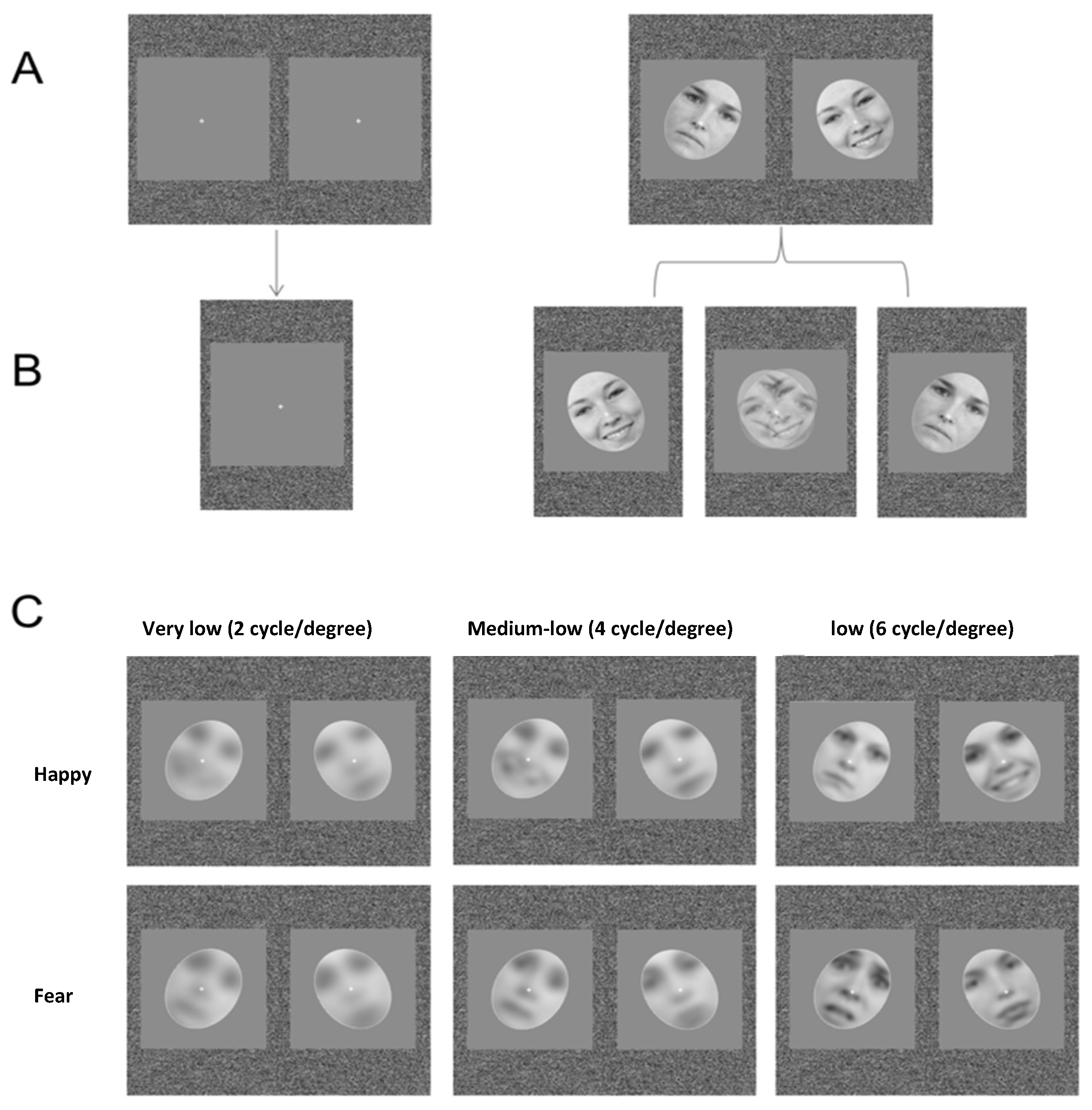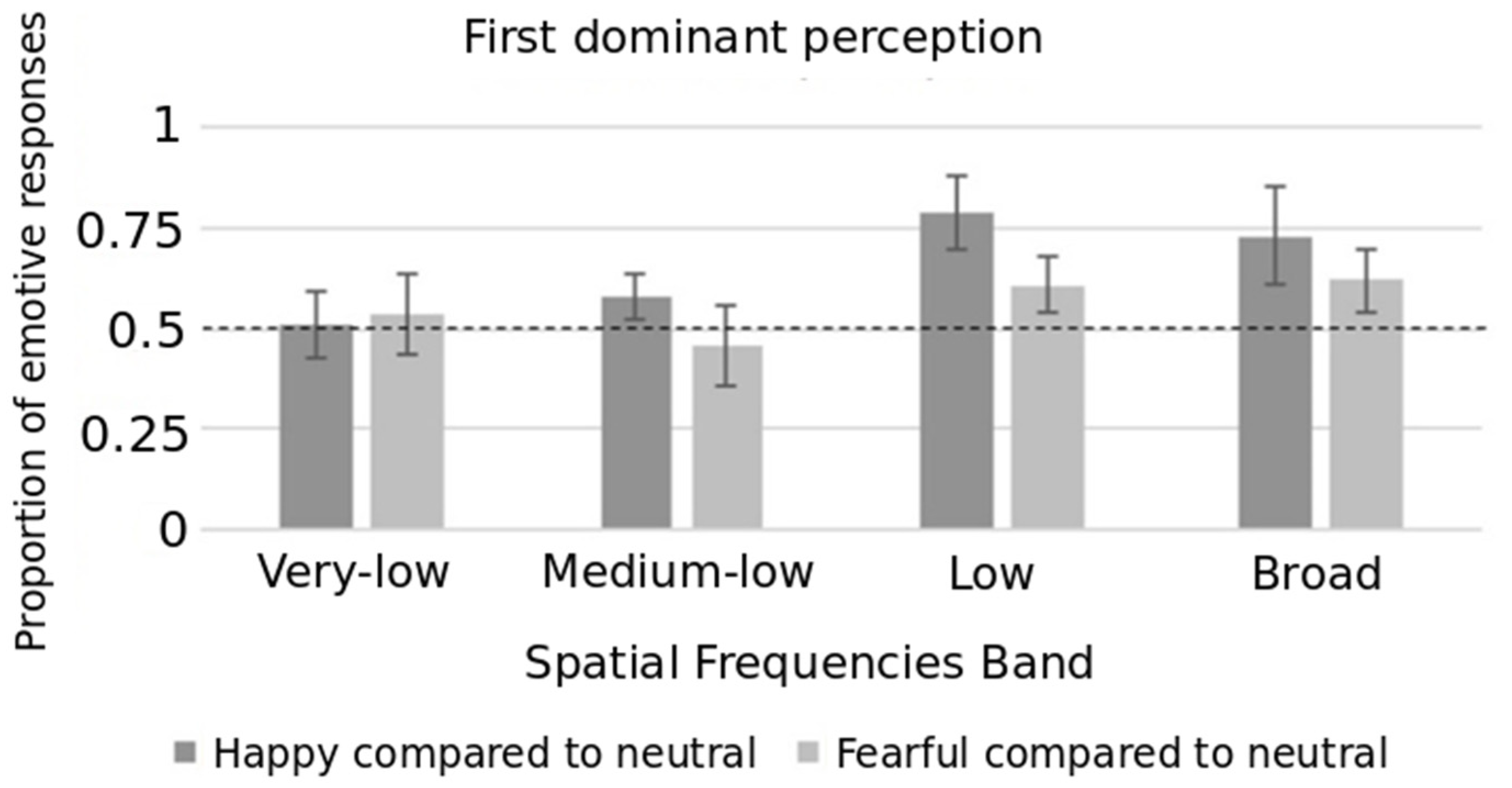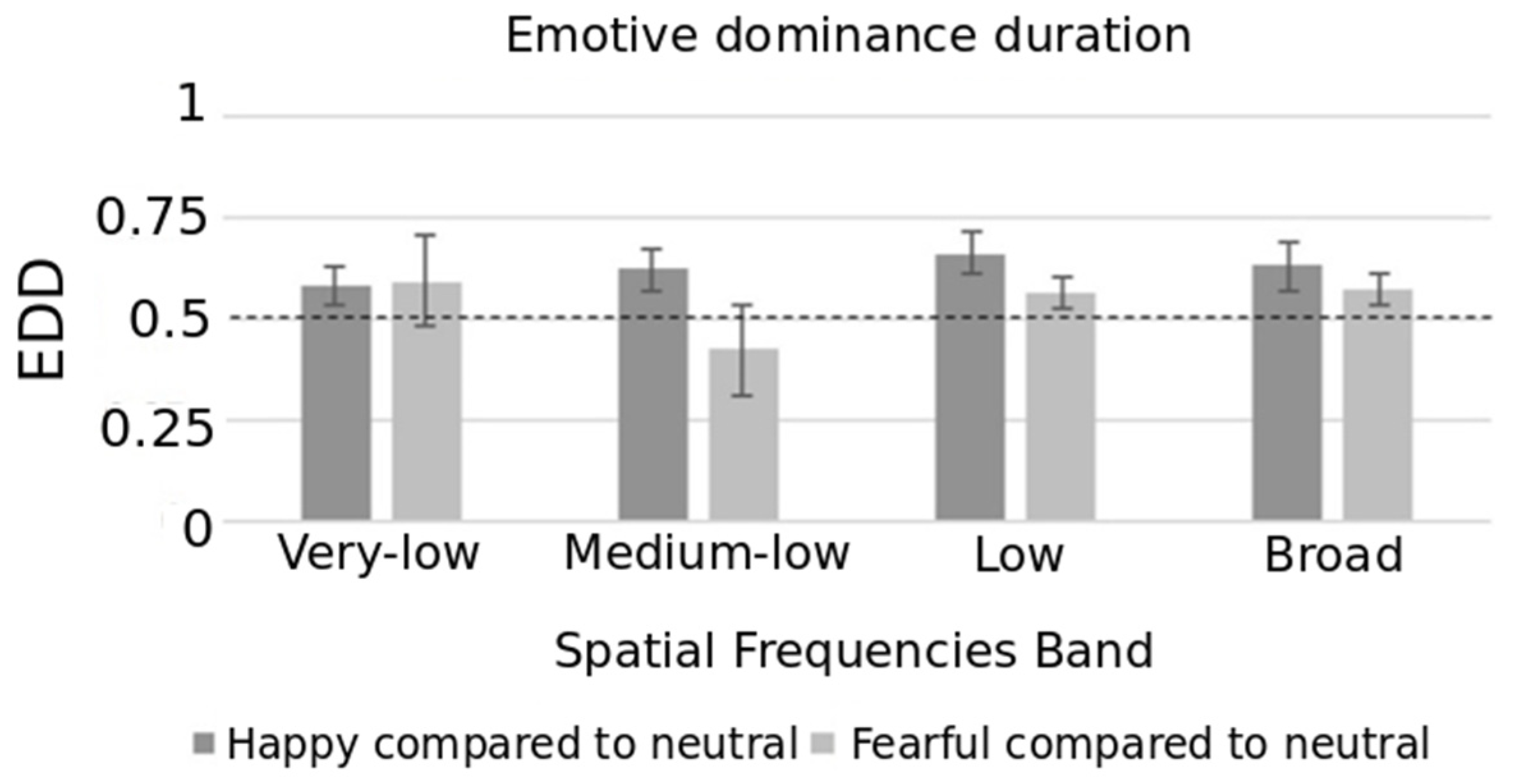Spatially Filtered Emotional Faces Dominate during Binocular Rivalry
Abstract
1. Introduction
2. Materials and Methods
2.1. Participants
2.2. Stimuli
2.3. Apparatus and Procedures
2.4. Statistical Analyses
3. Results
3.1. First Dominant Percept
3.2. Emotive Dominance Duration
4. Discussion
5. Conclusions
Author Contributions
Funding
Conflicts of Interest
References
- Lang, P.J.; Bradley, M.M.; Cuthbert, B.N. Motivated attention: Affect, activation, and action. In Attention and Orienting; Lang, P.J., Simons, R.F., Balaban, M., Eds.; Erlbaum: Mahwah, NJ, USA, 1997; pp. 97–135. [Google Scholar]
- Fox, E.; Russo, R.; Georgiou, G.A. Anxiety modulates the degree of attentive resources required to process emotional faces. Cogn. Affect. Behav. Neurosci. 2005, 5, 396–404. [Google Scholar] [CrossRef] [PubMed]
- Milders, M.; Sahraie, A.; Logan, S.; Donnellon, N. Awareness of faces is modulated by their emotional meaning. Emotion 2006, 6, 10–17. [Google Scholar] [CrossRef] [PubMed]
- Calder, A.J.; Young, A.W. Understanding the recognition of facial identity and facial expression. Nat. Rev. Neurosci. 2005, 6, 641–651. [Google Scholar] [CrossRef] [PubMed]
- Pessoa, L. On the relationship between emotion and cognition. Nat. Rev. Neurosci. 2008, 9, 148–158. [Google Scholar] [CrossRef] [PubMed]
- Williams, M.A.; Mattingley, J.B. Unconscious perception of non-threatening facial emotion in parietal extinction. Exp. Brain Res. 2004, 154, 403–406. [Google Scholar] [CrossRef]
- Amting, J.M.; Greening, S.G.; Mitchell, D.G. Multiple Mechanisms of Consciousness: The neural correlates of emotional awareness. J. Neurosci. 2010, 30, 10039–10047. [Google Scholar] [CrossRef]
- Ekman, P. An argument for basic emotions. Cogn. Emot. 1992, 6, 169–200. [Google Scholar] [CrossRef]
- Seligman, M.E.P.; Csikszentmihalyi, M. Positive psychology. An introduction. Am. Psychol. 2000, 55, 5–14. [Google Scholar] [CrossRef]
- Sylvers, P.D.; Brennan, P.A.; Lilienfeld, S.O. Psychopathic traits and preattentive threat processing in children: A novel test of the fearlessness hypothesis. Psychol. Sci. 2011, 22, 1280–1287. [Google Scholar] [CrossRef]
- Yang, E.; Zald, D.H.; Blake, R. Fearful expressions gain preferential access to awareness during continuous flash suppression. Emotion 2007, 7, 882–886. [Google Scholar] [CrossRef]
- Ritchie, K.L.; Bannerman, R.L.; Sahraie, A. The effect of fear in the periphery in binocular rivalry. Perception 2012, 41, 1395–1401. [Google Scholar] [CrossRef] [PubMed]
- Balconi, M. Consciousness and Emotion: Attentive vs. Pre-attentive Elaboration of Face Processing. In Encyclopedia of the Sciences of Learning; Seel, N.M., Ed.; Springer: Boston, MA, USA, 2012. [Google Scholar] [CrossRef]
- Dolan, R.J. Emotion, Cognition, and Behavior. Science 2002, 298, 1191. [Google Scholar] [CrossRef] [PubMed]
- Oliver, L.D.; Mao, A.; Mitchell, D.G. “Blindsight” and subjective awareness of fearful faces: Inversion reverses the deficits in fear perception associated with core psychopathic traits. Cogn. Emot. 2014, 29, 1256–1277. [Google Scholar] [CrossRef]
- Blake, R.; Logothetis, N.K. Visual competition. Nat. Rev. Neurosci. 2002, 3, 13–21. [Google Scholar] [CrossRef] [PubMed]
- Blake, R. A neural theory of binocular rivalry. Psychol. Rev. 1989, 96, 145–167. [Google Scholar] [CrossRef]
- Wilson, H.R.; Blake, R.; Lee, S.H. Dynamics of travelling waves in visual perception. Nature 2001, 412, 907–910. [Google Scholar] [CrossRef]
- Alpers, W.G.; Gerdes, B.M. Here is Looking at You: Emotional Faces Predominate in Binocular Rivalry. Emotion 2007, 7, 495–506. [Google Scholar] [CrossRef]
- Yu, K.; Blake, R. Do recognizable figures enjoy an advantage in binocular rivalry? J. Exp. Psychol. Hum. Percept. Perform. 1992, 18, 1158–1173. [Google Scholar] [CrossRef]
- Mueller, T.J.; Blake, R. A fresh look at the temporal dynamics of binocular rivalry. Biol. Cybern. 1989, 61, 223–232. [Google Scholar] [CrossRef]
- Breese, B.B. On inhibition. Psychol. Monogr. 1909, 3, 1–65. [Google Scholar] [CrossRef]
- Fahle, M. Binocular rivalry: Suppression depends on orientation and spatial frequency. Vis. Res. 1982, 22, 787–800. [Google Scholar] [CrossRef]
- Carter, O.L.; Campbell, T.G.; Liu, G.B.; Wallis, G. Contradictory influence of context on predominance during binocular rivalry. Clin. Exp. Optom. 2004, 87, 153–162. [Google Scholar] [CrossRef] [PubMed]
- Levelt, W. On Binocular Rivalry; Royal Van Gorcum: Assen, The Netherlands, 1965. [Google Scholar]
- Engel, E. The role of content in binocular resolution. Am. J. Psychol. 1956, 69, 87–91. [Google Scholar] [CrossRef] [PubMed]
- Alais, D.; Blake, R. Interactions between global motion and local binocular rivalry. Vis. Res. 1998, 38, 637–644. [Google Scholar] [CrossRef]
- Sobel, K.V.; Blake, R. How context influences predominance during binocular rivalry. Perception 2002, 31, 813–824. [Google Scholar] [CrossRef]
- Van Ee, R.; van Dam, G.J.; Brouwer, V. Voluntary control and the dynamics of perceptual bi-stability. Vis. Res. 2005, 45, 41–55. [Google Scholar] [CrossRef]
- Vuilleumier, P.; Armony, J.L.; Driver, J.; Raymond, D.J. Distinct spatial frequency sensitivities for processing faces and emotional expressions. Nat. Neurosci. 2003, 6, 624–631. [Google Scholar] [CrossRef]
- Pourtois, G.; de Gelder, B.; Bol, A.; Crommelinck, M. Perception of facial expressions and voices and of their combination in the human brain. Cortex 2005, 41, 49–59. [Google Scholar] [CrossRef]
- Srinivasan, N.; Hanif, A. Global-happy and local-sad: Perceptual processing affects emotion identification. Cogn. Emot. 2010, 24, 1062–1069. [Google Scholar] [CrossRef]
- Badcock, J.C.; Whitworth, F.A.; Badcock, D.R.; Lovegrove, W.J. Low-frequency filtering and the processing of local-global stimuli. Perception 1990, 19, 617–629. [Google Scholar] [CrossRef]
- Shulman, G.L.; Wilson, J. Spatial frequency and selective attention to local and global information. Perception 1987, 16, 89–101. [Google Scholar] [CrossRef] [PubMed]
- Srinivasan, N.; Gupta, R. Rapid communication: Global-local processing affects recognition of distractor emotional faces. J. Exp. Psychol. 2011, 64, 425–433. [Google Scholar] [CrossRef] [PubMed]
- McKone, E.; Davies, A.A.; Darke, H.; Crookes, K.; Wickramariyaratne, T.; Zappia, S.; Fiorentini, C.; Favelle, S.; Broughton, M.; Fernando, D. Importance of the inverted control in measuring holistic face processing with the composite effect and part-whole effect. Front. Psychol. 2013, 4, 33. [Google Scholar] [CrossRef] [PubMed]
- Persike, M.; Meinhardt-Injac, B.; Meinhardt, G. The face inversion effect in opponent-stimulus rivalry. Front. Hum. Neurosci. 2014, 8, 295. [Google Scholar] [CrossRef][Green Version]
- Itti, L.; Koch, C. A saliency-based search mechanism for overt and covert shifts of visual attention. Vis. Res. 2000, 40, 1489–1506. [Google Scholar] [CrossRef]
- Itti, L.; Koch, C. Feature combination strategies for saliency-based visual attention systems. J. Electron. Imaging 2001, 10, 161–169. [Google Scholar] [CrossRef]
- Itti, L.; Koch, C.; Niebur, E. A model of saliency-based visual attention for rapid scene analysis. IEEE Trans. Pattern Anal. Mach. Intell. 1998, 11, 1254–1259. [Google Scholar] [CrossRef]
- Parkhurst, D.; Law, K.; Niebur, E. Modeling the role of salience in the allocation of overt visual attention. Vis. Res. 2002, 42, 107–123. [Google Scholar] [CrossRef]
- Caudek, C.; Ceccarini, F.; Sica, C. Posterror speeding after threat-detection failure. J. Exp. Psychol. Hum. Percept. Perform. 2015, 41, 324–341. [Google Scholar] [CrossRef]
- Humphrey, K.; Underwood, G.; Lambert, T. Salience of the lambs: A test of the saliency map hypothesis with pictures of emotive objects. J. Vis. 2012, 12, 1–15. [Google Scholar] [CrossRef]
- Calvo, M.G.; Nummenmaa, L. Detection of emotional faces: Salient physical features guide effective visual search. J. Exp. Psychol. Gen. 2008, 137, 471–494. [Google Scholar] [CrossRef] [PubMed]
- Righi, S.; Gronchi, G.; Pierguidi, G.; Messina, S.; Viggiano, M.P. Aesthetic shapes our perception of every-day objects: An ERP study. New Ideas Psychol. 2017, 47, 103–112. [Google Scholar] [CrossRef]
- Demaree, H.; Everhart, D.; Youngstrom, E.; Harrison, D. Brain Lateralization of Emotional Processing: Historical Roots and a Future Incorporating “Dominance”. Behav. Cogn. Neurosci. Rev. 2005, 4, 3–20. [Google Scholar] [CrossRef] [PubMed]
- Langner, O.; Dotsch, R.; Bijlstra, G.; Wigboldus, D.H.J.; Hawk, S.T.; van Knippenberg, A. Presentation and validation of the Radboud Faces Database. Cogn. Emot. 2010, 24, 1377–1388. [Google Scholar] [CrossRef]
- Vannucci, M.; Viggiano, M.P.; Argenti, F. Identification of spatially filtered stimuli as function of the semantic category. Cogn. Brain Res. 2001, 12, 475–478. [Google Scholar] [CrossRef]
- Veser, S.; O’Shea, R.P.; Schröger, E.; Trujillo-Barreto, N.J.; Roeber, U. Early correlates of visual awareness following orientation and colour rivalry. Vis. Res. 2008, 48, 2359–2369. [Google Scholar] [CrossRef]
- Purcell, D.G.; Stewart, A.L. Still another confounded face in the crowd. Atten. Percept. Psychophys. 2010, 72, 2115–2127. [Google Scholar] [CrossRef]
- Walther, D.; Koch, C. Modeling attention to salient proto-objects. Neural Netw. 2006, 19, 1395–1407. [Google Scholar] [CrossRef]
- Carmel, D.; Arcaro, M.; Kastner, S.; Hasson, U. How to create and use binocular rivalry. J. Vis. Exp. 2010, 45, e2030. [Google Scholar] [CrossRef]
- Adolphs, R. Recognizing emotion from facial expressions: Psychological and neurological mechanism. Behav. Cogn. Neurosci. Rev. 2002, 1, 21–62. [Google Scholar] [CrossRef]
- Hess, U.; Blairy, S.; Kleck, R.E. The intensity of emotional facial expressions and decoding accuracy. J. Nonverbal Behav. 1997, 21, 241–257. [Google Scholar] [CrossRef]
- Cacioppo, J.T.; Gardner, W.L. Emotion. Annu. Rev. Psychol. 1999, 50, 91–214. [Google Scholar] [CrossRef] [PubMed]
- Dawson, M.E.; Schell, A.M.; Swerdlow, N.R.; Filion, D.L. Cognitive, clinical, and neuropsychological implications of startle modulation. In Attention and Orienting: Sensory and Motivational Processes; Mahwah, N., Lang, P., Simons, R., Balaban, M., Eds.; Lawrence Erlbaum Associates: Mahwah, NJ, USA, 1997; pp. 257–279. [Google Scholar]
- Fredrickson, B.L. What Good Are Positive Emotions? Rev. Gen. Psychol. 1998, 2, 300–319. [Google Scholar] [CrossRef] [PubMed]
- Folkman, S.; Moskowitz, J.T. Positive affect and the other side of coping. Am. Psychol. 2000, 55, 647–654. [Google Scholar] [CrossRef] [PubMed]
- Tugade, M.M.; Fredrickson, B.L.; Barrett, L.F. Psychological resilience and positive emotional granularity: Examining the benefits of positive emotions on coping and health. J. Personal. 2004, 72, 1161–1190. [Google Scholar] [CrossRef]
- Calvo, M.G.; Gutiérrez-García, A.; Fernández-Martín, A.; Nummenmaa, L. Recognition of Facial Expressions of Emotion is Related to their Frequency in Everyday Life. J. Nonverbal Behav. 2014, 38, 549–567. [Google Scholar] [CrossRef]
- Leppänen, J.M.; Hietanen, J.K. Positive facial expressions are recognized faster than negative facial expressions, but why? Psychol. Res. 2004, 69, 22–29. [Google Scholar] [CrossRef]
- Hedger, N.; Gray, K.L.H.; Garner, M.; Adams, W.J. Are visual threats prioritized without awareness? A critical review and meta-analysis involving 3 behavioral paradigms and 2696 observers. Psychol. Bull. 2016, 142, 934–968. [Google Scholar] [CrossRef]
- Moors, P.; Gayet, S.; Hedger, N.; Stein, T.; Sterzer, P.; van Ee, R.; Wagemans, J.; Hesselmann, G. Three Criteria for Evaluating High-Level Processing in Continuous Flash Suppression. Trends Cogn. Sci. 2019, 23, 267–269. [Google Scholar] [CrossRef]
- Stein, T.; Sterzer, P. Not Just Another Face in The Crowd: Detecting Emotional Schematic Faces During Continuous Flash Suppression. Emotion 2012, 12, 988–996. [Google Scholar] [CrossRef] [PubMed]
- Bannerman, R.L.; Milders, M.; De Gelder, B.; Sahraie, A. Influence of emotional facial expressions on binocular rivalry. Ophthalmic Physiol. Opt. 2008, 28, 317–326. [Google Scholar] [CrossRef] [PubMed]
- Turano, M.T.; Lao, J.; Richoz, A.R.; De Lissa, P.; Degosciu, S.B.A.; Viggiano, M.P.; Caldara, R. Fear boosts the early neural coding of faces. Soc. Cogn. Affect. Neurosci. 2017, 12, 1959–1971. [Google Scholar] [CrossRef] [PubMed]
- Williams, L.M.; Palmer, D.; Liddell, B.; Song, L.; Gordon, E. The when and where of perceiving signals of threat versus non—Threat. Neuroimage 2006, 31, 458–467. [Google Scholar] [CrossRef] [PubMed]
- Almeida, P.R.; Ferreira-Santos, F.; Chaves, P.L.; Paiva, T.O.; Barbosa, F.; Marques-Teixeira, J. Perceived arousal of facial expressions of emotion modulates the N170, regardless of emotional category: Time domain and time–frequency dynamics. Int. J. Psychophysiol. 2016, 99, 48–56. [Google Scholar] [CrossRef]
- Hinojosa, J.A.; Mercado, F.; Carretie, L. N170 sensitivity to facial expression: A meta-analysis. Biobehav. Rev. 2015, 55, 498–509. [Google Scholar] [CrossRef]
- Fenske, M.J.; Eastwood, J.D. Modulation of focused attention by faces expressing emotion: Evidence from flanker tasks. Emotion 2003, 3, 327–343. [Google Scholar] [CrossRef]
- Pierguidi, L.; Righi, S.; Gronchi, G.; Marzi, T.; Caharel, S.; Giovannelli, F.; Viggiano, M.P. Emotional contexts modulate intentional memory suppression of neutral faces: Insights from ERPs. Int. J. Psychophysiol. 2016, 106, 1–13. [Google Scholar] [CrossRef]
- Gronchi, G.; Righi, S.; Pierguidi, L.; Giovannelli, F.; Murasecco, I.; Viggiano, M.P. Automatic and controlled attentional orienting in the elderly: A dual-process view of the positivity effect. Acta Psychol. 2018, 185, 229–234. [Google Scholar] [CrossRef]
- Righi, S.; Gronchi, G.; Marzi, T.; Rebai, M.; Viggiano, M.P. You are that smiling guy I met at the party! Socially positive signals foster memory for identities and contexts. Acta Psychol. 2015, 159, 1–7. [Google Scholar] [CrossRef]
- Hernández-Lorca, M.; Sandberg, K.; Kessel, D.; Fernández-Folgueiras, U.; Overgaard, M.; Carretié, L. Binocular rivalry and emotion: Implications for neural correlates of consciousness and emotional biases in conscious perception. Cortex 2019, 120, 539–555. [Google Scholar] [CrossRef]



Publisher’s Note: MDPI stays neutral with regard to jurisdictional claims in published maps and institutional affiliations. |
© 2020 by the authors. Licensee MDPI, Basel, Switzerland. This article is an open access article distributed under the terms and conditions of the Creative Commons Attribution (CC BY) license (http://creativecommons.org/licenses/by/4.0/).
Share and Cite
Turano, M.T.; Giganti, F.; Gavazzi, G.; Lamberto, S.; Gronchi, G.; Giovannelli, F.; Peru, A.; Viggiano, M.P. Spatially Filtered Emotional Faces Dominate during Binocular Rivalry. Brain Sci. 2020, 10, 998. https://doi.org/10.3390/brainsci10120998
Turano MT, Giganti F, Gavazzi G, Lamberto S, Gronchi G, Giovannelli F, Peru A, Viggiano MP. Spatially Filtered Emotional Faces Dominate during Binocular Rivalry. Brain Sciences. 2020; 10(12):998. https://doi.org/10.3390/brainsci10120998
Chicago/Turabian StyleTurano, Maria Teresa, Fiorenza Giganti, Gioele Gavazzi, Simone Lamberto, Giorgio Gronchi, Fabio Giovannelli, Andrea Peru, and Maria Pia Viggiano. 2020. "Spatially Filtered Emotional Faces Dominate during Binocular Rivalry" Brain Sciences 10, no. 12: 998. https://doi.org/10.3390/brainsci10120998
APA StyleTurano, M. T., Giganti, F., Gavazzi, G., Lamberto, S., Gronchi, G., Giovannelli, F., Peru, A., & Viggiano, M. P. (2020). Spatially Filtered Emotional Faces Dominate during Binocular Rivalry. Brain Sciences, 10(12), 998. https://doi.org/10.3390/brainsci10120998




